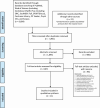Systematic Review of Exercise for Caregiver-Care Recipient Dyads: What Is Best for Spousal Caregivers-Exercising Together or Not at All?
- PMID: 32614050
- PMCID: PMC8361501
- DOI: 10.1093/geront/gnaa043
Systematic Review of Exercise for Caregiver-Care Recipient Dyads: What Is Best for Spousal Caregivers-Exercising Together or Not at All?
Abstract
Background and objectives: Though exercise for care recipients receives considerable emphasis, few dyadic studies focus on caregivers. This systematic review identified dyadic exercise interventions, which measured outcomes for older adult caregivers. Studies that met inclusion criteria were examined to better understand whether caregivers derived greater benefit from exercising with care recipients, or not exercising at all.
Research design and methods: PRISMA guidelines were followed to identify quantitative studies of dyadic exercise interventions in which caregivers enrolled with care recipients, and either coparticipated in exercise; or while their care recipients exercised independently, caregivers received a separate, nonexercise intervention or usual care (UC). To be included, studies had to measure physical or psychosocial outcomes for caregivers. Study quality was assessed via the Downs and Black checklist.
Results: Eleven studies met inclusion criteria. In six, the dyad exercised; in five, care recipients exercised while caregivers received a separate program, or UC. Results suggest that caregivers may improve both psychosocial and physical health when exercising together with care recipients. Caregivers who did not exercise but received a separate, nonexercise intervention, such as support, education, or respite, showed psychosocial benefits. Those who received UC were less likely to derive physical or psychosocial benefits. Included studies were fair to good quality with moderate to high risk of bias.
Discussion and implications: Often examined secondarily, caregivers are overlooked for participation in interventions with care recipients. This analysis suggests that caregivers may benefit from dyadic interventions in which they either exercise together with their care recipients or receive a separate nonexercise intervention or respite.
Keywords: Family caregivers; Psychosocial health; physical activity; physical health.
© The Author(s) 2020. Published by Oxford University Press on behalf of The Gerontological Society of America.
Figures
References
-
- Baanders, A. N., & Heijmans, M. J. (2007). The impact of chronic diseases: The partner’s perspective. Family & Community Health, 30, 305–317. doi:10.1097/01.FCH.0000290543.48576.cf - DOI - PubMed
-
- Bauman, A., Merom, D., Bull, F. C., Buchner, D. M., & Fiatarone Singh, M. A. (2016). Updating the evidence for physical activity: Summative reviews of the epidemiological evidence, prevalence, and interventions to promote “active aging”. The Gerontologist, 56(Suppl 2), S268–S280. doi:10.1093/geront/gnw031 - DOI - PubMed
Publication types
MeSH terms
Grants and funding
LinkOut - more resources
Full Text Sources
Medical
Miscellaneous



